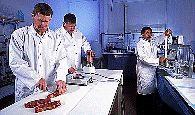United States Department of Agriculture: Agricultural Research Service, Lincoln, Nebraska
Date of this Version
1988
Document Type
Article
Abstract
Twinning is relatively rare in most breeds of beef cattle - less than 1 to 2% of calvings and less frequent for immature females. Twin calving has generally been considered undesirable because of the smaller calf size, higher calf mortality, infertility of females born twin with a male, more retained placentas, and possible delayed rebreeding experienced with twin calvings when observed under feeding and management that is geared to single calving. However, costs for just maintaining the breeding herd account for over one-half of the total costs of beef production. Thus genetic twinning may offer a means of increasing total beef output much more than input costs, especially if genetic selection and appropriate feeding and management changes would reduce some of the undesirable effects of twinning.



Comments
Published in Beef Research Program Progress Report (1988) No. 3: 31-33